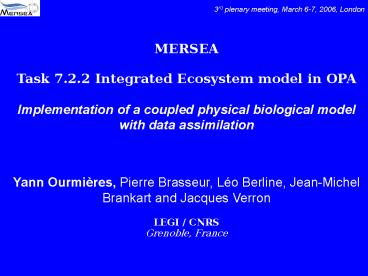3rd plenary meeting, March 67, 2006, London - PowerPoint PPT Presentation
1 / 15
Title:
3rd plenary meeting, March 67, 2006, London
Description:
... physical biological model with data assimilation. Yann Ourmi res, Pierre Brasseur, L o Berline, Jean-Michel Brankart and Jacques Verron ... L. Berline, J-M. ... – PowerPoint PPT presentation
Number of Views:25
Avg rating:3.0/5.0
Title: 3rd plenary meeting, March 67, 2006, London
1
3rd plenary meeting, March 6-7, 2006,
London MERSEA Task 7.2.2 Integrated Ecosystem
model in OPA Implementation of a coupled
physical biological model with data
assimilation Yann Ourmières, Pierre Brasseur,
Léo Berline, Jean-Michel Brankart and Jacques
Verron LEGI / CNRS Grenoble, France
2
- Main goals for the 7.2 task
- Development of a state-of-the-art biogeochemical
model (NPZD global ecomodel, low resolution to
high resolution) - Implement and adapt a data assimilation
methodology into a coupled physical-biogeochemical
model (subtask 7.2.2) - Realize the necessary transfers for a
demonstration experiment at global scale and high
resolution (1/4) of a coupled physico-biogeochemi
cal assimilating model
3
Context of the study
- Expertise in assimilation of physical data for
circulation models (SEEK filter developed at the
LEGI, transfered to MERCATOR SAM2) - ? Interest in understanding the impact of
physical data assimilation on the coupled system
and especially on the ecosystem response - On-line coupled model
- 3D Basin-scale configuration
- Use of physical data only for assimilation
4
Main results after 12 months Beta version
developed and assessed
5
Prototype of a coupled physical-biological
assimilative system
- Beta-version details
- OPA model rigid lid, eddy permitting
resolution (1/3) - OPA 8.1, North Atlantic domain (MNATL)
- First generation biogeochemical model NPZD
- - 1 nutrient (PO4)
- - coupled on line
- Sequential assimilation scheme (SEEK filter)
- - Singular Evolutive Extended Filter (Pham et
al., 1998) - - Assimilated data
- - Surface physical data only
- (TP/ERS altymetry, AVHRR
SST)
6
Summary of the coupled beta-version
performance without assimilation
(year 1998)
7
Annual maximum of the mixed layer depth (m) for
1998
Free run
Assimilated run
Climatology from in-situ data (De Boyer Montegut
et al.,2004)
8
Impact on the ecosystem Spring mean of surface
Chl-a (mg/m3) for 1998
Assimilated run
Free run
underestimation
Gradient still too strong
Observations (SeaWifs)
mg/m3
L. Berline, J-M. Brankart, P. Brasseur, Y.
Ourmières, and J. Verron Improving the physics
of a coupled physical-biogeochemical model of the
North Atlantic through data assimilation impact
on the ecosystem, in revision for the Journal of
Marine Systems, special issue AMEMR symposium
june 2005
9
- Problems highlighted
- Nutrient input strongly affected by data
assimilation, but its effect depends on the
region - Remaining flaws of the biological model response
(e.g. grazing at high latitudes, subtropical gyre
too oligotrophic...) - Discontinuous nature of the sequential
assimilation system leading to unrealistic
vertical advection - Consistent modification of the assimilation
system ? - By obtaining a continuous assimilated solution
(use of IAU as a first step to a SEEK smoother) - By performing more consistent corrections
between the physical and the biogeochemical
variables.
10
Work progress after 18 months Platform upgraded
and assessment in progress
11
Upgrade of the assimilated coupled model OPA9
LOBSTER - AS
- Physical model OPA9 in NATL4 configuration
- OPA9 bulk forcing (mld control, S.Skachko),
free surface, partial steps - NATL4 North Atlantic domain
- ¼ resolution
- 45 vertical level, thickness of
6m (surf.) to 250m (bottom) - Biogeochemical model LOBSTER
- N2PZD2 model of intermediate complexity
- 2 nutrients
- Coupled on-line to the physical model
- Assimilation system (AS) SEEK IAU
- Implementation of IAU filtering to obtain a
continuous solution and to reduce analysis
induced shocks. - Assimilated data
- - Surface physical data only
- (TP/ERS altymetry, AVHRR SST)
12
First results of the upgraded coupled system
without assimilation
SeaWifs monthly climatological Chlorophyll a for
May
Chlorophyll a (mg/m3) from a model snapshot. Date
29/05/96. No assimilation
13
Work plan for subtask 7.2.2
- 1) Evaluation of the performance of the coupled
system, focusing on the biogeochemical component
response - Assessment based on metrics developed with
beta-version and WP 7.2.3. - Modification / enhancement of assimilation system
for key coupling mechanism (vertical advection,
mixed layer dynamics...)
2) 2 years simulation (98-99) and validation
with data such as ocean colour products
(SeaWifs) 3) Transfer for demonstration with the
MERCATOR system
14
WP 7.2.2 Schedule
0 6 12 18 24
30 36 42
48 04/04 10/04 04/05
10/05 04/06 10/06 04/07
10/07 04/08
15
Research directions for the assimilative system
- Use of ocean colour data for a better parameter
estimation - Assimilation method using flux correction
(presentation from S. Skachko) - Combining surface and in-situ data for
assimilation and/or validation































